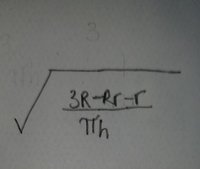The formula for the volume of a frustum of a cone, V, is given below:
. . . . .[math]V\, =\, \dfrac{1}{3}\, \pi\, h\, \left(R^2\, +\, Rr\, +\, r^2\right)[/math]
...where R is the major radius, r is the minor radius, and h is the height.
(i) Develop a quadratic equation representing the solution in terms of r.
(ii) Using the Quadratic Formula, solve for r, giving the answer to 2 decimal places.
(iii) Describe how you could also graphically solve this quadratic equation
Could anyone help im really lost
Thanks
. . . . .[math]V\, =\, \dfrac{1}{3}\, \pi\, h\, \left(R^2\, +\, Rr\, +\, r^2\right)[/math]
...where R is the major radius, r is the minor radius, and h is the height.
(i) Develop a quadratic equation representing the solution in terms of r.
(ii) Using the Quadratic Formula, solve for r, giving the answer to 2 decimal places.
(iii) Describe how you could also graphically solve this quadratic equation
Could anyone help im really lost
Thanks
Attachments
Last edited by a moderator:


